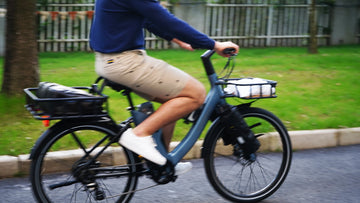Electric bikes. You’ve heard about them. You’ve seen them. Perhaps you own one or know electric bike industry well. E-bikes are showing up everywhere. There are many factors increasing the trend of e-bike ownership in the United States. They are a sustainable and alternative mode of transportation. They are an excellent way to stay active and get outdoors. They are even a great way to save some money compared to driving a car for all your errands.
However, with increased ownership and more uses than ever, many people still do not have enough knowledge about e-bike laws and regulations in different states. Not knowing the e-bike speed limit and helmet laws for your route could result in a legal fine or even a safety issue if you find yourself in an accident after losing control of your bike. Therefore, it is more critical than ever to find out the speed limits as well as bike helmet laws which may protect yourself and others in the future.

Speed Limit
First and foremost, it is significant to know how the U.S. legally defines electric bikes. According to U.S. Code Title 15, Chapter 47, Section 2085(d), the definition of a low-speed electric bicycle is “a two- or three-wheeled vehicle with fully operable pedals and an electric motor of less than 750 watts (1 horsepower), whose maximum speed on a paved level surface, when powered solely by such a motor while ridden by an operator who weighs 170 pounds, is less than 20 mph.”
Many States in the U.S. have adopted a three-class system to describe the different levels of electric bikes. The classes are as follows:
- Class 1: pedal assist only; maximum assisted speed of 20 mph.
- Class 2: throttle assist only; maximum motor-powered speed of 20 mph.
- Class 3: pedal assist only; maximum assisted speed of 28 mph.
It can be clearly seen that class 1 and 2 are regulated like regular bicycles and will follow the same rules and be allowed to use the same paths and infrastructure as regular bicycles. However, because class 3 e-bikes are capable of higher speeds, they have extra regulations and require additional equipment, although, they are still technically considered a bicycle. Examples include long range electric bikes such as the Himiway Cruiser and Himiway Step-Thru.
Currently, as stated by U.S. Federal Law, class 3 e-bikes have a minimum age of 16 years old to operate and require a helmet. Class 3 e-bikes are also not allowed on standard bike paths. The reason that class 3 e-bikes are allowed to travel at speeds up to 28 mph is because the Consumer Product Safety Commission has clarified that the law does allow e-bikes to travel faster than 20 mph when using foot pedaling and the e-bike’s motor power at the same time.
Pedal Requirements
Whichever state you live in or visit, one mandatory feature of your electric bike is that it must have fully operational pedals. This means the bike needs to be able to use the pedals powered by you, the rider, at any time. You do not need to always use the pedals, but they do need to be fully functional.
Motor Power Size
All three classes of e-bikes require a motor with 1 horsepower (750 watts) or less. This is good news, as Himiway eBikes come with a standard 1 horsepower / 750 watt hub motor. This is the perfect amount of power to get you where you need to go while maintaining a safe speed. Whether you are commuting in the bike lane of a busy road, getting some thrills on an all-terrain trail, or enjoying a leisurely summer activity, you can ride with confidence knowing that your Himiway e-bike meets the requirement of U.S. law.
Helmet Laws
According to nolo.com, different states have different laws regarding helmet requirements when using your e-bike. Below is a table that outlines whether a helmet is necessary or not when riding an e-bike. Regardless if a bike helmet law is applicable or not, it is always a good idea to protect yourself from accidents with a reliable and comfortable bike helmet. In addition, just because there is no state law noted below, does not mean there is not a local law that you need to follow. Please always check with your local or state laws for any updates to this information.
| State | Helmet required on an e-bike? | State | Helmet required on an e-bike? | State | Helmet required on an e-bike? |
| Alabama | Yes, all ages | Louisiana | Yes, all ages | Ohio | Yes, under 18 |
| Alaska | No | Maine | Yes, under 16 | Oklahoma | No |
| Arizona | No | Maryland | Yes, all ages | Oregon | Yes, under 16 |
| Arkansas | Yes, under 21 | Massachusetts | Yes, all ages | Pennsylvania | No |
| California | Yes, all ages | Michigan | Yes, under 18 | Rhode Island | Yes, under 16 |
| Colorado | Yes, under 18 | Minnesota | No | South Carolina | No |
| Connecticut | Yes, under 16 | Mississippi | No | South Dakota | No |
| Delaware | Yes, under 18 | Missouri | No | Tennessee | Yes, all ages |
| Florida | Yes, under 16 | Montana | No | Texas | No |
| Georgia | Yes, all ages | Nebraska | No | Utah | Yes, under 21 |
| Hawaii | Yes, under 16 | Nevada | No | Vermont | No |
| Idaho | No | New Hampshire | Yes, under 18 | Virginia | Yes, all ages |
| Illinois | No | New Jersey | Yes, under 17 | Washington | No |
| Indiana | Yes, under 18 | New Mexico | No | West Virginia | Yes, all ages |
| Iowa | No | New York | Yes, all ages | Wisconsin | No |
| Kansas | Yes, under 18 | North Carolina | No | Wyoming | No |
| Kentucky | Yes, under 21 | North Dakota | No |
Safe Passing Laws
Following the proper procedure for safe passing allows you and those around you to enjoy the path or road. Safe passing laws do vary by state and can be reviewed here. You will always want to be aware of your surroundings, the other bicyclists, and especially any motor vehicles nearby. You should always pass other riders on the left and announce your approach. The use of accessories such as bike mirrors and bells can also help notify others that you are nearby. Consider wearing bright or reflective gear when traveling on narrow roads to help drivers of motor vehicles see you and give you extra space as well.
In general, you will need to give other riders and pedestrians a minimum of 3 feet between yourself and them when passing. Automobiles should give riders the same distance of safety, and if not available, the automobiles should slow down to pass bicyclists. However, never assume that automobile drivers will be paying attention to the road. They may be distracted by their phones or other cars. Other riders may be distracted as well, especially if they are new or young. A good rule of thumb is that you should never pass anyone if it would create a dangerous situation for you, them, or any other person.

Conclusion
Now you should have a good understanding of e-bike laws and regulations. With proper education and increased awareness, there is always fun and safety to be found with any electric bike you choose. Always remember that laws and regulations are subject to change. While there are general laws at the Federal level concerning e-bike speed limits, e-bike helmet laws and related regulations, many states have slightly different interpretations and enforcements of such laws. Please always consult your latest local and state laws.





































